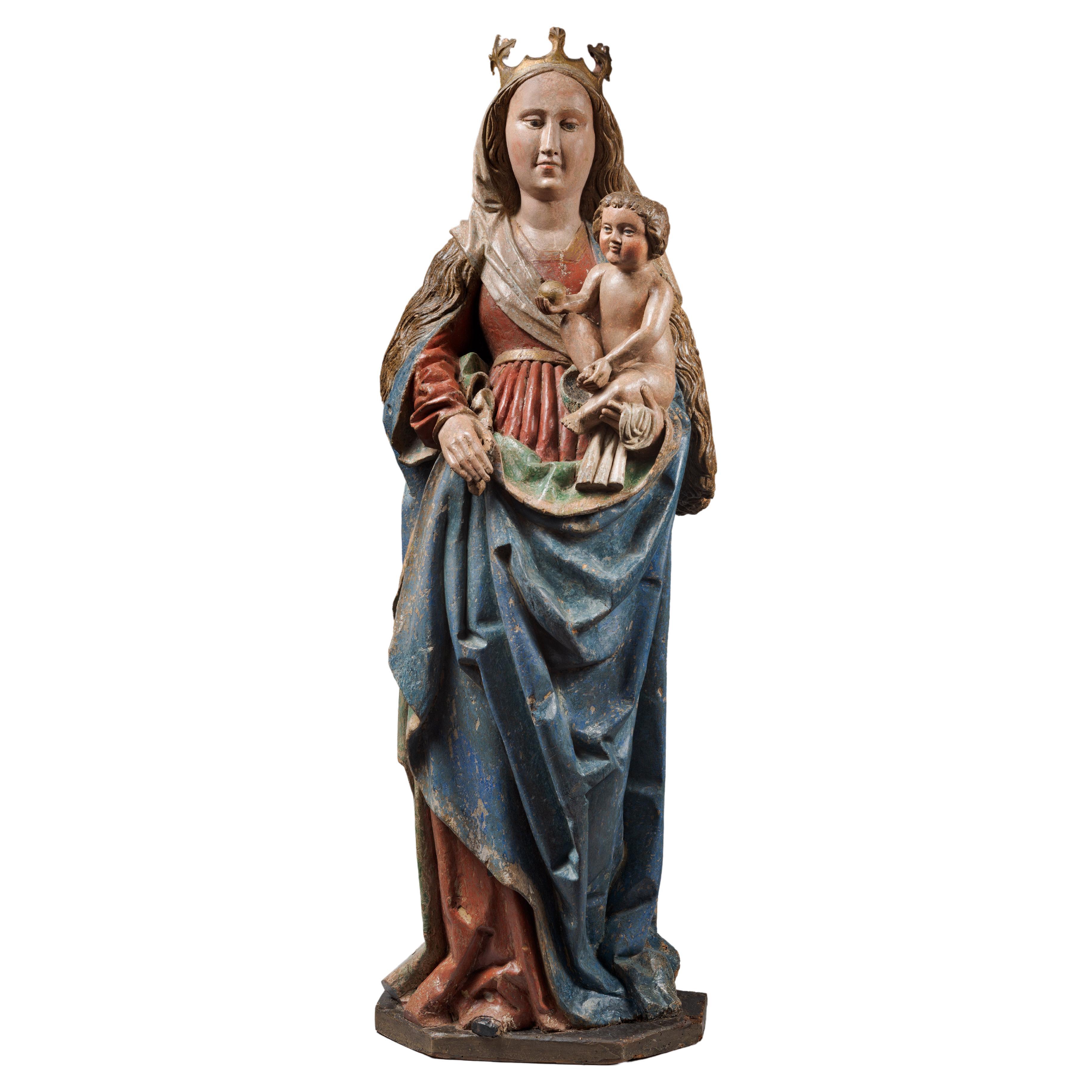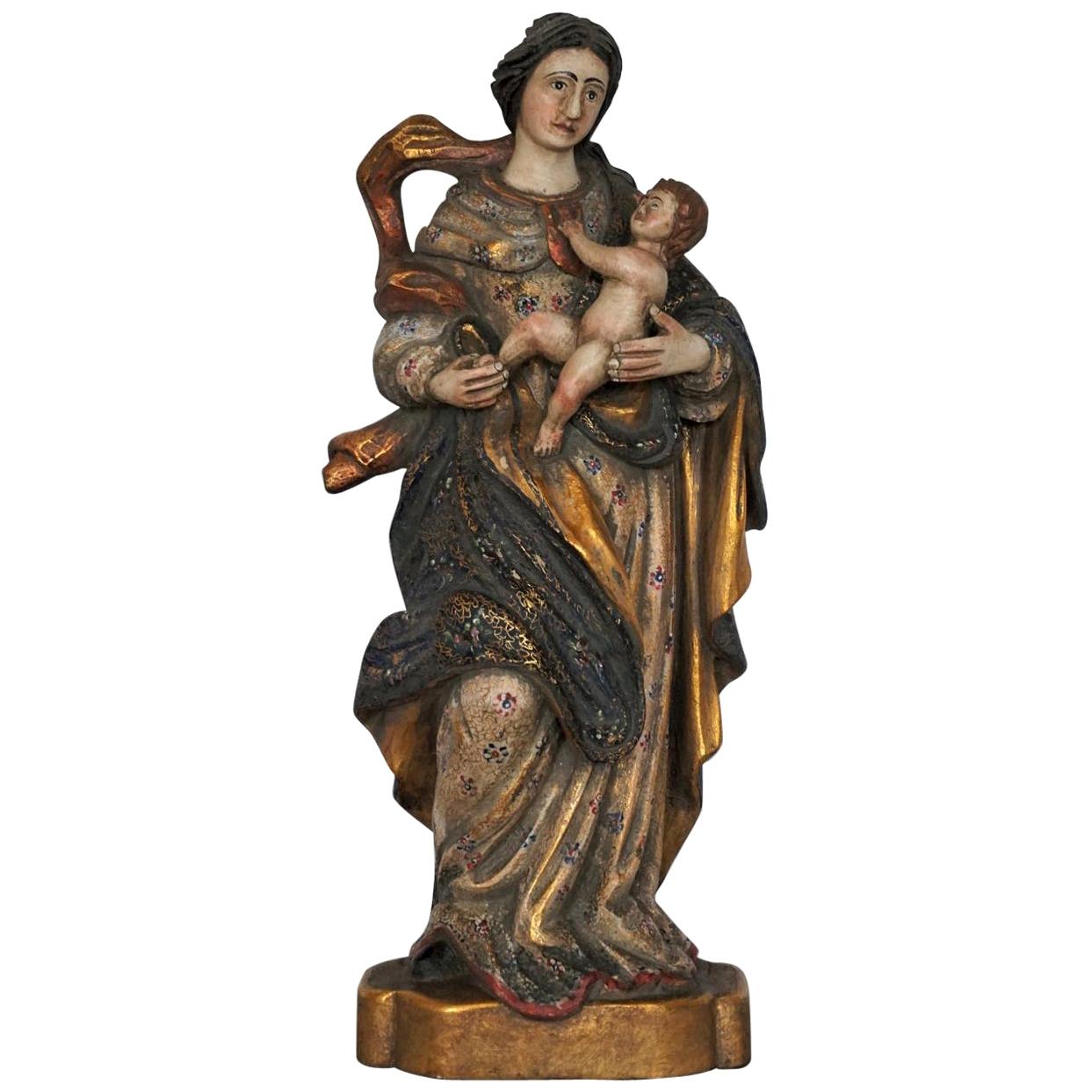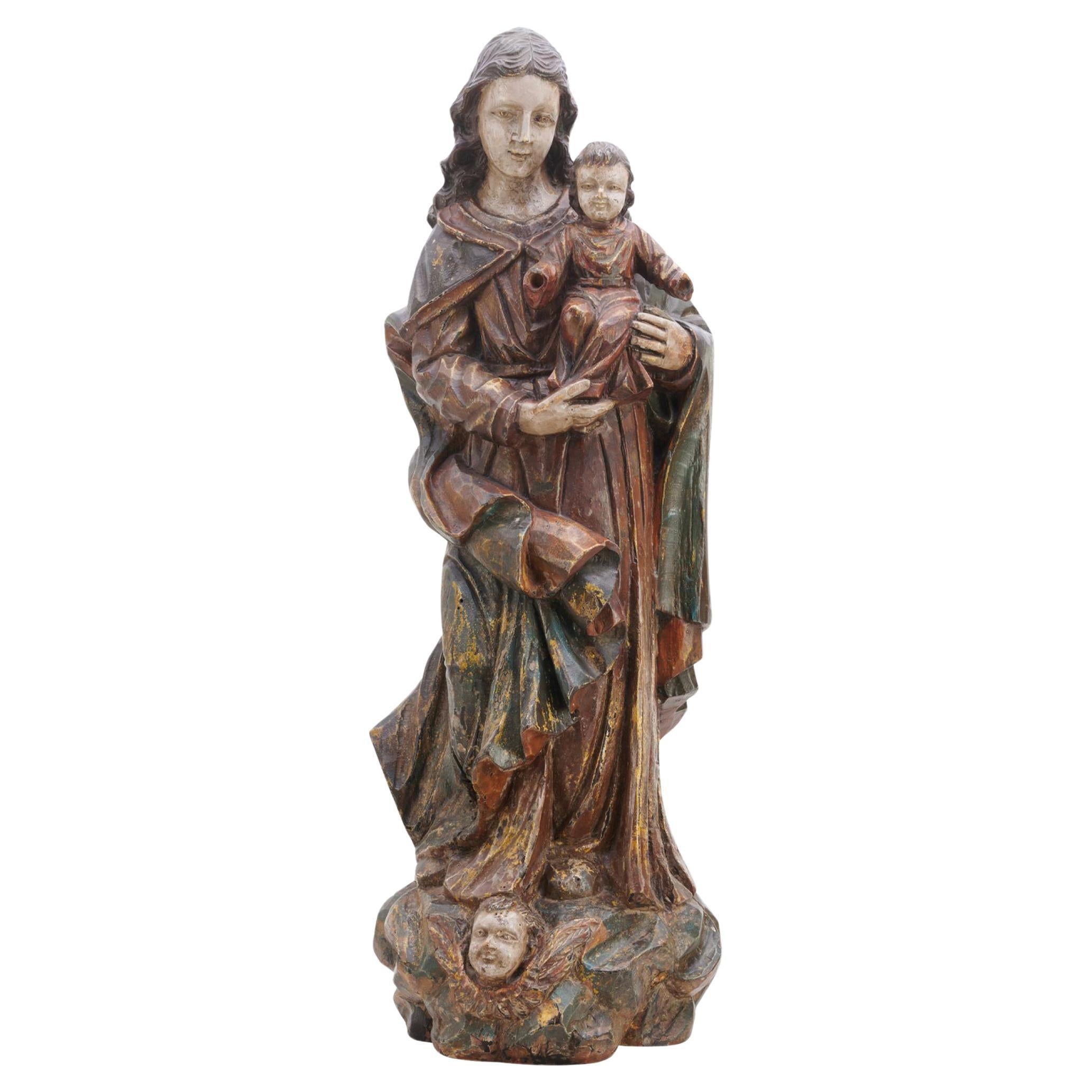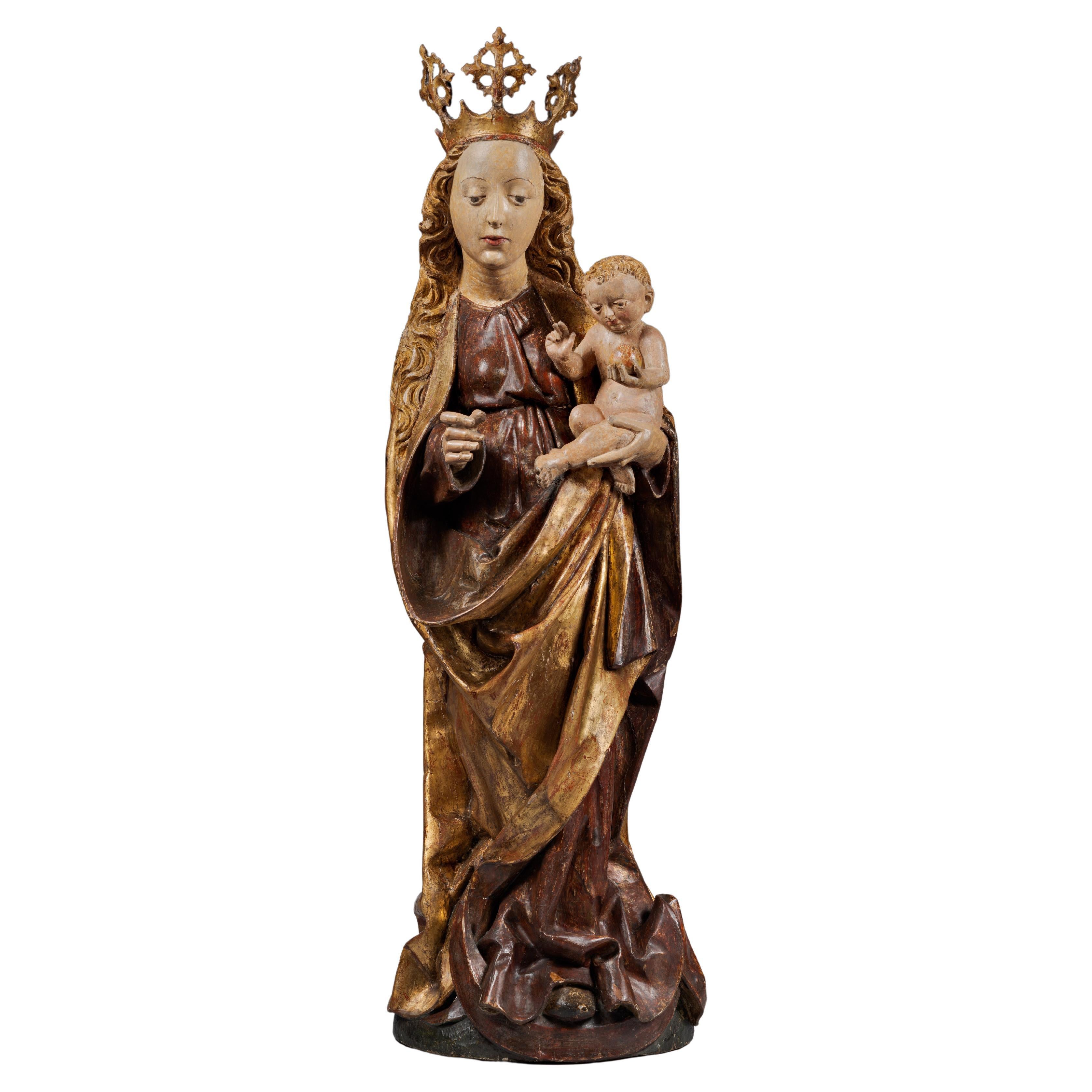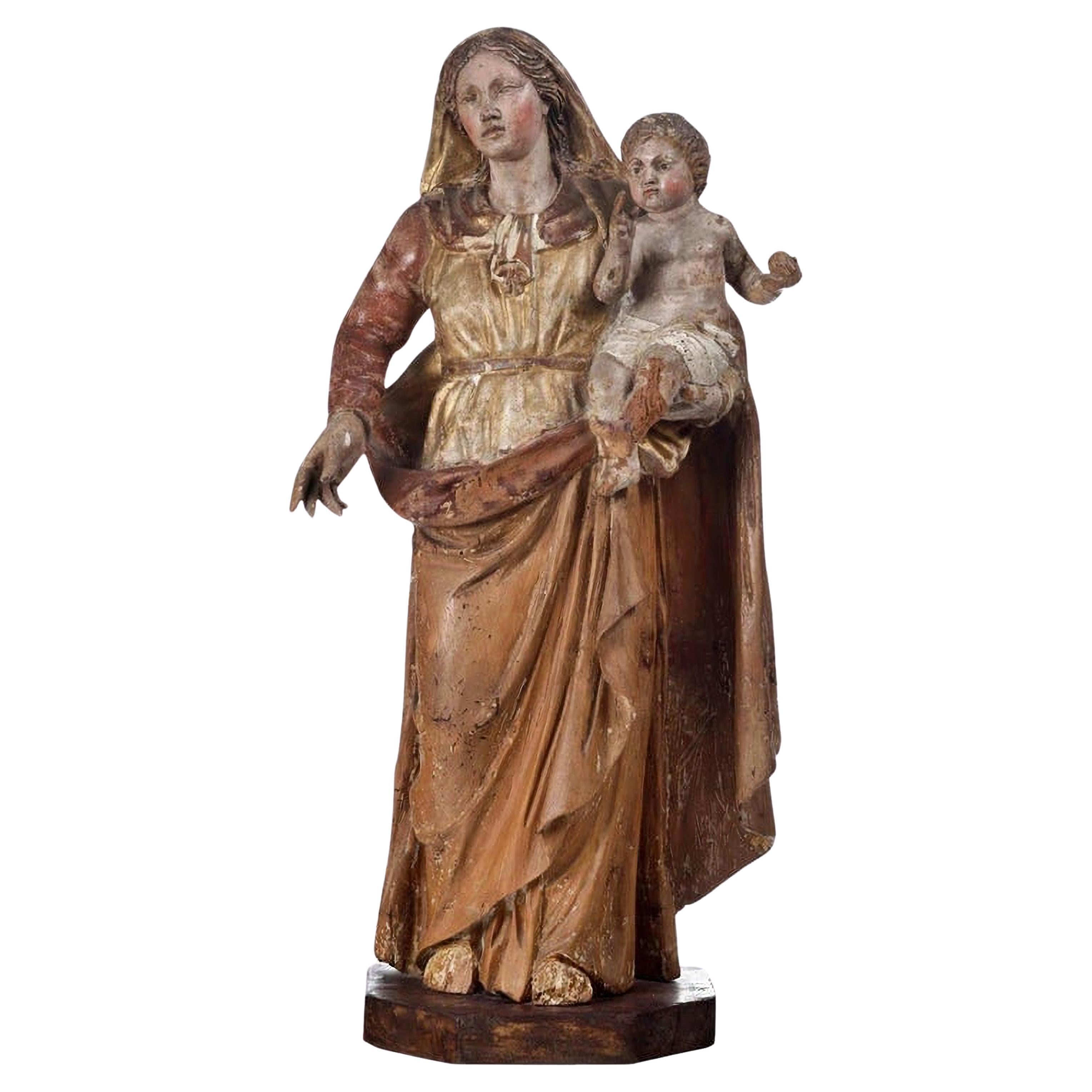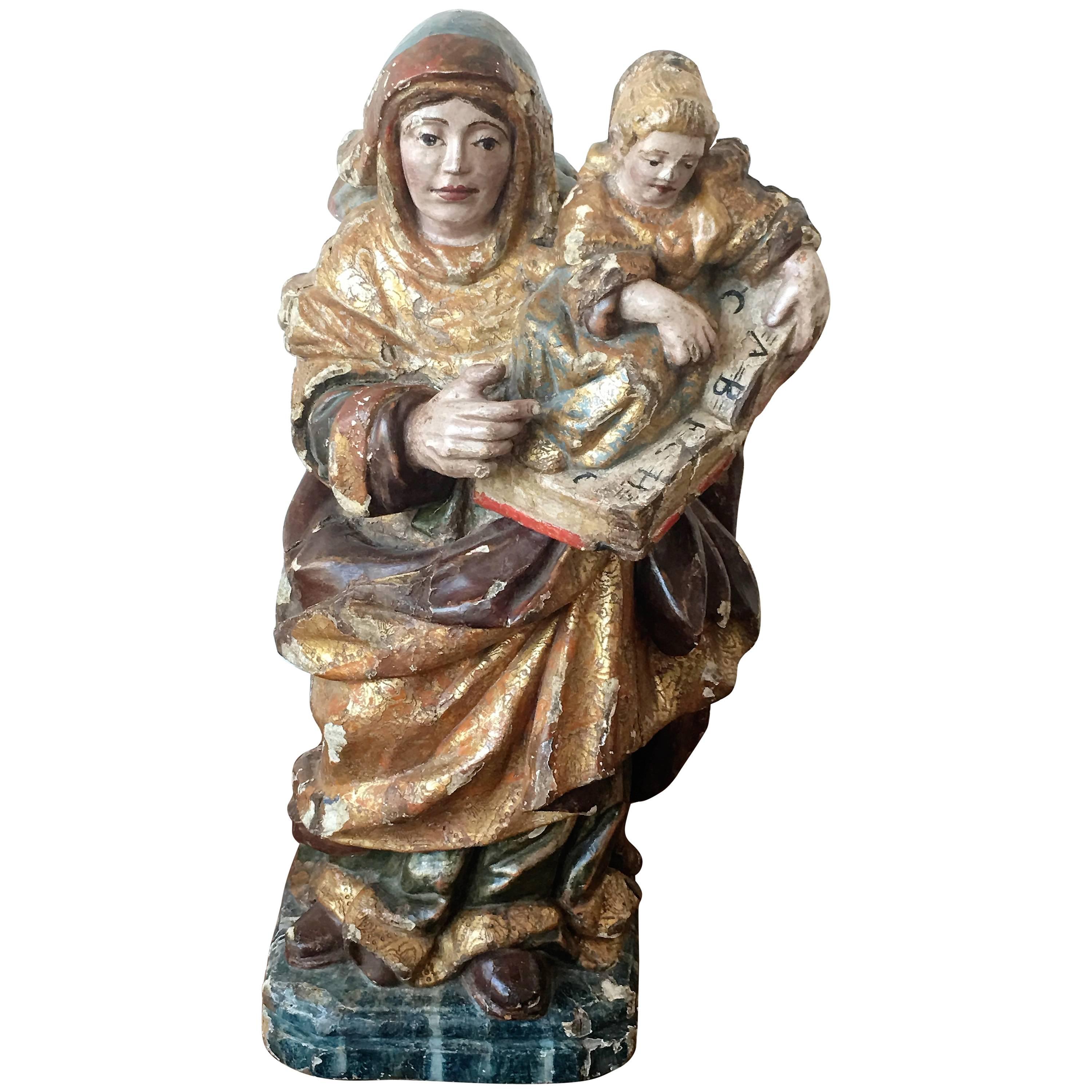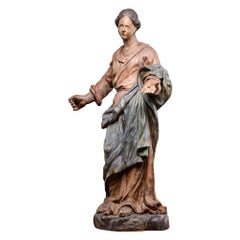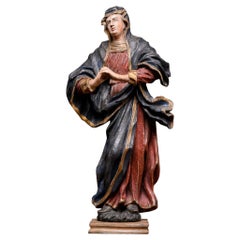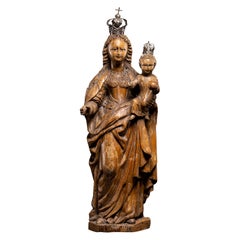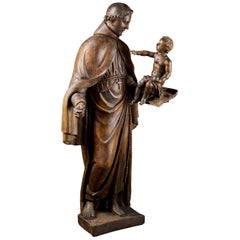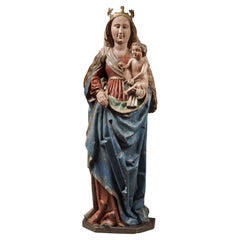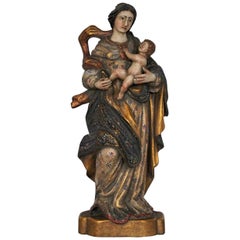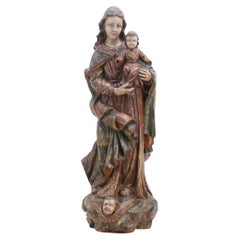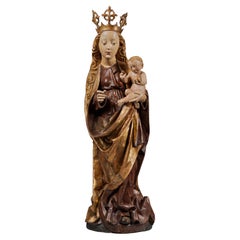Items Similar to 18th C, Southern France, Madonna and Child, Carved and Polychrome Wood
Want more images or videos?
Request additional images or videos from the seller
1 of 7
18th C, Southern France, Madonna and Child, Carved and Polychrome Wood
$4,623.82
£3,460.43
€3,900
CA$6,378.97
A$7,093.68
CHF 3,725.75
MX$86,727.30
NOK 46,426.44
SEK 43,767.59
DKK 29,688.74
About the Item
Although the 18th century, the period of the Enlightenment in France, spawned thinkers who criticised the privileges of the clergy and the truthfulness of certain dogmas, the Roman Catholic faith was very much present in everyday life. Since king Louis XIV had issued the Edict of Fontainebleau in 1685, Protestantism was banned. This Madonna with child illustrates the daily practice of faith. Like many 18th-century Madonna statues of the south of France, this Virgin has no delicate facial features. Even though the sculptor has paid a lot of attention to the rhythm of the folds, the figure remains rather heavy. An iron hook is attached to the back of the statue to anchor it. The polychrome and gilding on the front are still intact.
- Dimensions:Height: 26.38 in (67 cm)Width: 10.63 in (27 cm)Depth: 5.12 in (13 cm)
- Materials and Techniques:
- Place of Origin:
- Period:
- Date of Manufacture:Unknown
- Condition:Wear consistent with age and use.
- Seller Location:Leuven , BE
- Reference Number:Seller: 19181stDibs: LU3301128678592
About the Seller
5.0
Vetted Professional Seller
Every seller passes strict standards for authenticity and reliability
Established in 2017
1stDibs seller since 2017
172 sales on 1stDibs
Typical response time: 4 hours
- ShippingRetrieving quote...Shipping from: leuven, Belgium
- Return Policy
Authenticity Guarantee
In the unlikely event there’s an issue with an item’s authenticity, contact us within 1 year for a full refund. DetailsMoney-Back Guarantee
If your item is not as described, is damaged in transit, or does not arrive, contact us within 7 days for a full refund. Details24-Hour Cancellation
You have a 24-hour grace period in which to reconsider your purchase, with no questions asked.Vetted Professional Sellers
Our world-class sellers must adhere to strict standards for service and quality, maintaining the integrity of our listings.Price-Match Guarantee
If you find that a seller listed the same item for a lower price elsewhere, we’ll match it.Trusted Global Delivery
Our best-in-class carrier network provides specialized shipping options worldwide, including custom delivery.More From This Seller
View All17th C Polychromed Fruitwood Carved Statue Depicting Madonna, France
Located in Leuven , BE
An exceptionally beautiful antique French wood carving, made in the 17th century. It depicts Madonna standing with open offering arms .The...
Category
Antique 17th Century Belgian Figurative Sculptures
Materials
Wood
18th C Polychromed Fruitwood Carved Statue Depicting Maria Magdalena, Germany
Located in Leuven , BE
Hard wood with rests of polychromy.
Category
Antique 18th Century French Figurative Sculptures
Materials
Wood
16th C Mechelen Doll-letter M carved in the back.Some leftovers of polychromy
Located in Leuven , BE
Mechelen dolls are rare wooden devotional figurines (mainly walnut was used), which were made by some members of the Guild of Saint Luke. The figures, all individual saints, were made from reference models using highly regulated carving and polychrome techniques. They had to meet several requirements. The shape of the rug had to meet certain criteria and the letter M (from Mechelen) had to be visible in the shape. These devotional or saint figurines...
Category
Antique 16th Century Belgian Figurative Sculptures
Materials
Fruitwood
Late 17th Century Italian School Wooden Sculpture of Saint Anthony and the Child
Located in Leuven , BE
According to the legends, there are two Saint Anthony’s, they can easily be distinguished by their hair. This one is known as Saint Anthony of Padua, he is recognizable by his hair, ...
Category
Antique Early 17th Century Italian Figurative Sculptures
Materials
Wood
Flemish School, Painting of Madonna and Child, Oil on Panel, Framed
Located in Leuven , BE
This lovely 17th century painting was made in the last part of the European Renaissance period, also known as the high renaissance, late 17th century. This scene depicts the Madonna with her Child...
Category
Antique 17th Century Belgian Decorative Art
Materials
Paint
17th C Stone statue of Saint Erasmus or Saint Elmo
Located in Leuven , BE
Saint Erasmus or Saint Elmo (Antioch, ca. 240 – Formia, 303) was an Italian bishop and patron saint of the sailors. His attribute was the capstan, a winch on which the anchor chains were rolled up. He died as a martyr for his faith, and his bones were transferred to Gaeta in the 9th century, where they are kept in the cathedral to this day. The electric phenomenon of Saint Elmus fire is named after Saint Erasmus and the 16th C humanist Desiderius Erasmus. Little is known with certainty about Saint Erasmus' life. However, many legends may have been passed on orally until the - no older writings are known with certainty. His birthplace was in present-day Syria. However, the persecution of Christians under Emperor Diocletian forced him to flee to Mount Lebanon...
Category
Antique 17th Century Belgian Figurative Sculptures
Materials
Stone
You May Also Like
Important 15th Century Polychrome Wood Virgin and Child
Located in Saint-Ouen, FR
Important 15th century polychrome wood virgin and child
Origin: Southern Germany
Period: Late 15th Century, Ca. 1480-1490
Height : 125 cm
Polychrome limewood
Good condition
Provenance : Private collection, Alsace, France.
As soon as 1430, sculpture starts a major and deep stylistic evolution than will unfold over a century, until around 1530. We call it the International Gothic. This production is particularly interested in a quest for realism.
This important Virgin and Child wears a long red dress with a round gilded neckline. A delicate golden belt...
Category
Antique 15th Century and Earlier Figurative Sculptures
Materials
Wood
Madonna Carved Wood Sculpture Gold Leaf and Polychrome, Spain, Mid-18th Century
Located in Frankfurt am Main, DE
A wood sculpture wonderfully carved depiction of the Virgin Mary with Jesus Child gilded with gold leaf and polychrome painted, Spain, mid-18th century...
Category
Antique Mid-18th Century Spanish Religious Items
Materials
Gold Leaf
$5,182 Sale Price
30% Off
A Carved Polychrome Painted Figure of the Virgin and Christ, 18th Century
Located in ARMADALE, VIC
A Carved and Polychrome-Painted Group of the Virgin and Christ, 18th Century
The modelled standing in robes holding the Christ child, on a rockwork base with a seraphim mask to the ...
Category
Antique 18th Century French Baroque Figurative Sculptures
Materials
Hardwood
Polychrome carved wood Virgin and Child from the 15th Century
Located in Saint-Ouen, FR
POLYCHROME CARVED WOOD VIRGIN AND CHILD FROM THE 15TH CENTURY
ORIGIN: SOUTH GERMANY, SWABIA, NUREMBERG REGION
PERIOD: 15th CENTURY
Height: 94,6cm
Width : 28 cm
Depth : 18 cm
Lime wood
Original Polychromy
Good state of conservation
From 1430 onwards, sculpture underwent a profound stylistic renewal which continued until 1530, the so-called late Gothic period. In the Germanic countries, original sculptures flourished in an expressive and sensitive vein.
This renewal was inspired by the art of Nicholas of Leiden, who was active in Strasbourg in the 1460's. His style broke with the refined and delicate art of the international Gothic style in force throughout Europe around 1400. The figures became more authentic and realistic. The bodies became denser. Clothes are animated by deep, broken folds, the fabrics are heavy and have a great decorative value. In addition, the polychromy is intended to be illusionistic. The painting makes it possible to restore the texture of the materials, the richness of the textiles and the natural skin tone of the characters.
The dissemination of images through engraving and the great mobility of the artists led to the success of this style, which conquered the Upper Rhine, Swabian, Tyrolean and Franconian regions, contributing to the formation of a common stylistic identity in these regions. The economic boom in the flourishing German cities was conducive to the development of original production. Attracted by this prosperity, numerous workshops were set up in order to meet the orders of religious communities, the Church and the laity, including a clientele of middle-class rockers.
This precious Virgin and Child is depicted standing on a crescent moon, her head encircled by a crown of tall flowers. Her long wavy hair spreads over her shoulders, framing her beautiful oval face. Under fine eyebrows drawn with a brushstroke, her almond-shaped, slightly drooping eyes look at the Child with infinite softness. She is dressed in a long red dress with a rounded neckline, belted under the chest. The heavy fabric of her dress spreads out in broken folds at her feet. On her shoulders she wears a golden cloak. The drapery has deep folds. She holds out her right hand while she holds the Christ Child with her left.
Christ, with his well-defined hair, is naked. His cheeks are highlighted with red, he holds an apple in his left hand and with the other hand makes a sign of blessing towards the faithful.
Virgins with Child on a crescent moon were very popular in the second half of the 15th century, especially as the central subject of altarpieces in southern Germany and Austria. The crescent moon on which Mary is standing is reminiscent of the Woman of the Apocalypse. Often equated with the Virgin Mary.
This episode is taken from the Book of Revelation (12:1-6)
1 Then a great sign appeared in heaven: a woman clothed with the sun, with the moon under her feet and a crown of twelve stars on her head. ; 2 She was pregnant, and she cried out because she was in labor, in pain from giving birth. ; 3 Then another sign appeared in heaven: it was a great fiery red dragon, with seven heads and ten horns, and seven royal crowns on his heads. ; 4 His tail swept down a third of heaven's stars and threw them to the earth. The dragon stood in front of the woman who was about to give birth so that when she gave birth, he might devour her child. ; 5 She gave birth to a son, a male child who is to rule all the nations with an iron rod. Her child was snatched up to God and his throne. ; 6 Then the woman fled into the desert, where God has prepared a place for her. There she will be taken care of for one thousand two hundred sixty days.
Some theologians see in this woman a reference to the Virgin Mary and in the child, Jesus.
This remarkable work is a very fine example of sculpture from Swabian workshops in the last decades of the 15th century. It presents all the characteristic stylistic elements: a highly girdled silhouette, an abundant drapery with angular folds, but also a great physical presence accentuated by the polychromy that restores the anatomical details. This group is made of a wooden log. The deep folds of the drapery highlight the movement of the Virgin holding the child.
Bibliography :
Sophie Guillot de Suduiraut, Dévotion et Séduction, Sculptures souabes des musées de France, vers 1460-1530, Paris musée du Louvre-Éditions somogy, 2015
“Revelation 12 - Common English Bible...
Category
Antique 15th Century and Earlier German Gothic Figurative Sculptures
Materials
Wood
Wooden Madonna with Child Baroque Art Italy 17th Century with Export Certificate
Located in Madrid, ES
A Wooden Madonna with child Baroque art, Southern Italy, 17th century.
Measure: H: 71cm
Good condition for the time.
With Export Certificate to USA.
Category
Antique Early 17th Century Italian Baroque Figurative Sculptures
Materials
Wood
$4,647 Sale Price
20% Off
16th Century Spanish Carved & Polychrome Painted Saint Anne with the Infant Mary
Located in Miami, FL
This sculpture represents Santa Ana (Saint Anne) with the infant Mary.
Verge
Category
Antique 16th Century European Baroque Religious Items
Materials
Wood
More Ways To Browse
18th Century French Carved Wood
King Louis Xiv
Polychrome Wood Statue
Catholic Wood Carved
Antique Iron Anchor
Virgin Statue
Polychrome Virgin
Antique Catholic Statues
Madonna Statues
Madonna And Child Statues
Antique Wax Head
Roman Soldier
Wood Statue Stand
15th Century Wooden
Art Deco Woman Head
Child Sculpture Marble
Egyptian 1920s
Italian Alabaster Sculptures
